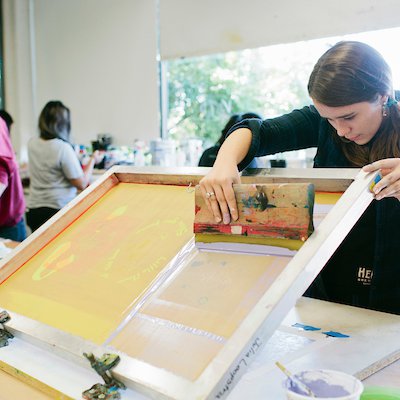ChatGPT said: Deep dive at 10:9 Design LLC Company screen printing process
Wiki Article
The Necessary Guide to Understanding Screen Printing and Its Versatile Uses
Screen printing has a rich history that dates back to ancient times, progressing into a sophisticated strategy used throughout different markets today. This overview checks out the details of the screen printing procedure, detailing its applications in fashion, marketing, and home style - 10:9 Design Embroidery. Understanding these fundamentals can open creative potential for both industrial and imaginative tasks. The complying with areas will reveal necessary suggestions and strategies to improve one's screen printing endeavorsThe History of Screen Printing
Although screen printing has roots that map back centuries, its advancement mirrors the imaginative and technological improvements of various cultures. Stemming in old China, the method was initially used for decorating fabrics and later infect Japan, where it became indispensable to Ukiyo-e woodblock printing. The method changed to Europe in the 18th century, where it got appeal among craftsmens and commercial printers. The invention of picture emulsion in the 20th century transformed screen printing, permitting for even more intricate designs and better performance. Musicians like Andy Warhol additionally pushed its popularity, using the tool to develop renowned jobs that mixed commercialism and great art. By the late 20th century, screen printing had actually established itself as a functional method, utilized in fashion, marketing, and fine art. Today, it continues to develop, integrating digital technology and expanding its applications throughout different sectors.The Screen Printing Process Explained
Screen printing transforms creative visions into substantial styles through a collection of accurate steps. A picture is created and after that transferred onto a screen, usually made of fine mesh material extended over a frame. A light-sensitive emulsion is applied to the screen, which is exposed to light, solidifying in locations not covered by the image. After cleaning out the unhardened emulsion, a stencil is developed.Next off, the screen is placed over the substrate, whether it be textile, paper, or one more product. Ink is after that pressed with the open locations of the pattern making use of a squeegee, depositing the design onto the substratum below. This process can be duplicated for multiple colors, requiring separate screens for every tone. Ultimately, the published product is treated using warmth to ensure the ink sticks appropriately, causing a durable, vibrant layout on-line.
Sorts Of Screen Printing Techniques

In addition, specialized methods, such as discharge screen printing, eliminate dye from the material to produce softer prints, while foil screen printing uses metal foil to achieve a shiny surface (10:9 Design Screen Printing). Each strategy provides distinctive qualities, accommodating numerous imaginative needs and production scales, eventually broadening the possibilities within the screen printing domain name
Applications of Screen Printing in Numerous Industries

Furthermore, the signs and marketing markets utilize screen printing for creating eye-catching screens and banners. This technique allows for vibrant colors and elaborate styles that catch attention. In electronics, screen printing is used for applying conductive inks to circuit boards, necessary for component connections. Moreover, the home style industry embraces screen printing to generate distinctive layouts on fabrics and wall surface art. In general, screen printing acts as a crucial device across varied fields, improving items with customized and visually appealing graphics.
Tips for Effective Screen Printing Projects
While embarking on a screen printing project, mindful focus to detail can considerably boost the last outcome. Selecting high-grade products is necessary; this includes the screen, inks, and substratums. Utilizing suitable mesh counts can impact ink deposition and detail resolution. Prep work is similarly vital; complete cleansing of screens and proper direct exposure times assure crisp site prints.Next, exact registration is critical for multi-color prints. Making use of placement devices can help achieve exact layering. Furthermore, screening prints on scrap materials before manufacturing helps determine prospective concerns without losing resources.

Often Asked Concerns
What Products Are Best for Screen Printing on Material?
Cotton and polyester blends are perfect for screen printing on fabric as a result of their resilience and ink absorption. Furthermore, specialty textiles like silk or canvas can generate special structures and surfaces, boosting the general style high quality.Just how Do I Tidy and Maintain Screen Printing Devices?
To keep and clean screen printing devices, one must consistently wash displays with suitable solvents, check squeegees for wear, oil moving components, and shop all items in a dry, dust-free setting to lengthen their life-span.What Are the Environmental Effects of Screen Printing?
Screen printing can have substantial environmental effects, including chemical waste from solvents and inks, water use during cleaning processes, and energy intake. Sustainable methods and environment-friendly materials are vital for lessening these adverse effects.Can Screen Printing Be Done in the house Successfully?
Screen printing can be successfully done at home with the best materials and strategies. Hobbyists can produce high quality prints, though success depends upon their ability degree, tools, and understanding of the procedure entailed.
What Are the Prices Related To Beginning a Display Printing Business?

Beginning a screen printing organization includes prices for tools, products, and work area. First costs usually range from a couple of hundred to a number of thousand bucks, depending upon the range, high quality of equipment, and wanted production capability.
Screen printing has an abundant background that dates back to ancient times, evolving right into an innovative technique utilized across different industries today. An additional strategy, rotary screen printing, employs round displays, assisting in continuous printing on material rolls, thus boosting efficiency for massive productions. In addition, specialty strategies, such as discharge screen printing, remove dye from the textile to develop softer prints, while foil screen printing applies metallic foil Going Here to accomplish a glossy coating. In the fashion sector, screen printing is widely used to develop vivid styles on apparel, allowing brand names to display their unique styles. Cotton and polyester blends are suitable for screen printing on textile due to their sturdiness and see this website ink absorption.
Report this wiki page